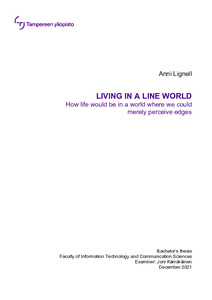Living in a line world: How life would be in a world where we could merely perceive edges
Lignell, Anni (2022)
Lignell, Anni
2022
Tieto- ja sähkötekniikan kandidaattiohjelma - Bachelor's Programme in Computing and Electrical Engineering
Informaatioteknologian ja viestinnän tiedekunta - Faculty of Information Technology and Communication Sciences
This publication is copyrighted. You may download, display and print it for Your own personal use. Commercial use is prohibited.
Hyväksymispäivämäärä
2022-02-01
Julkaisun pysyvä osoite on
https://urn.fi/URN:NBN:fi:tuni-202201141332
https://urn.fi/URN:NBN:fi:tuni-202201141332
Tiivistelmä
Vision has been the most researched topic of the human senses throughout history. The human visual system is a complex system consisting of dorsal and ventral streams, the former of which handles information in object recognition and the latter one in motion perception. Although edge detection is part of the primary visual cortex, being able to only perceive edges changes vision drastically from what an average human being is used to.
Edges are resulted by different physical phenomena, such as lighting variations caused by shadows or variances in albedo between objects. They can occur between objects as well as within a single object, and in many situations all these phenomena can occur at the same time. However not all edges are equally informative in the case of edge detection and can sometimes create rather confusing scenes. This thesis explores whether edge detection provides too much complex and unnecessary information, or whether only perceiving edges causes us to lose crucial information necessary to live a normal everyday life.
The experiments were done considering both ventral and dorsal streams as well as the hierarchy of human visual system. This refers to experiments in both object recognition and motion perception as well as hand-eye coordination and navigating in different environments. The goal was to explore the impact of edge detection on everyday life in as many ways as possible.
The results revealed significant effects on both dorsal and ventral streams. Object recognition became significantly more difficult, while on the other hand motion perception and moving around in different environments had a slighter change. Merely being able to detect edges limits the person’s ability to perform certain tasks but does not make everyday tasks completely impossible. Humans are very adaptive and with time living in the line world could become more plausible.
Edges are resulted by different physical phenomena, such as lighting variations caused by shadows or variances in albedo between objects. They can occur between objects as well as within a single object, and in many situations all these phenomena can occur at the same time. However not all edges are equally informative in the case of edge detection and can sometimes create rather confusing scenes. This thesis explores whether edge detection provides too much complex and unnecessary information, or whether only perceiving edges causes us to lose crucial information necessary to live a normal everyday life.
The experiments were done considering both ventral and dorsal streams as well as the hierarchy of human visual system. This refers to experiments in both object recognition and motion perception as well as hand-eye coordination and navigating in different environments. The goal was to explore the impact of edge detection on everyday life in as many ways as possible.
The results revealed significant effects on both dorsal and ventral streams. Object recognition became significantly more difficult, while on the other hand motion perception and moving around in different environments had a slighter change. Merely being able to detect edges limits the person’s ability to perform certain tasks but does not make everyday tasks completely impossible. Humans are very adaptive and with time living in the line world could become more plausible.
Kokoelmat
- Kandidaatintutkielmat [7052]
